The Association of Theological Schools (ATS) recently gathered a group of mid-career faculty to discuss the daunting challenges that seminaries face. We explored ways that faculty can help lead their institutions in these times of trial and opportunity.
Seminaries are under competing pressures. On the one hand, new graduate-level theological schools continue to be established, and some of them seek accreditation from ATS — from 1997 to 2016, the number of ATS-accredited schools rose from 200 to 247 (+23.5%). During the same period, the total headcount of enrolled students at ATS-accredited schools rose from 65,416 to 73,372 (+12.2%), and the full-time equivalent (FTE) enrollment at all schools rose from 43,302 to 45,827 (+5.8%).
In effect, this means that over 20 years, the average FTE enrollment at ATS schools actually shrank from 216.5 to 185.5. The 16 largest ATS schools, with FTE enrollment of more than 500 each, skew the data and mask the stark reality that the vast majority of seminaries are small and getting smaller.
At the same time, many theological sch ools also feel a mounting pressure to justify our existence. Is what we offer — theology, biblical studies, practical ministry courses, spiritual formation — appealing to prospective students? Are we needed by faith communities?
ools also feel a mounting pressure to justify our existence. Is what we offer — theology, biblical studies, practical ministry courses, spiritual formation — appealing to prospective students? Are we needed by faith communities?
The responses to the enrollment crisis have varied. Some freestanding seminaries have closed or merged. Others are exploring alternative revenue streams, renting out or selling assets like land, buildings, or transferable real estate development rights (such as “air rights”).
One thing that nearly all seminaries are doing, to one extent or another, is revising their curricula to meet shifting demands and to make educational content (and the delivery of that content) more appealing to — and useful for — students.
Curriculum revision presents challenges on many fronts. Multiple allegiances and constituents push and pull in different directions. Pragmatic matters like finances sometimes come into conflict with a seminary’s mission objectives.
The most fundamental tension is that theological schools have a hard time deciding whether they are (on the one hand) graduate schools of theology, focusing on academic disciplines like Bible, ethics, church history, and leadership theory, or (on the other hand) vocational schools, focusing on preparing people for the hands-on work of ministry.
Over the past two decades, I’ve been involved in numerous curricular revision processes in three different institutions. I’ve observed the following six tensions that always seem to spring up:
-
Departmental turf wars. When the curriculum is revised, departmental conflicts arise. Sometimes they spring from basic self-preservation. Which courses will be removed from the curriculum — one of the foundational theology or Bible courses, or perhaps an ethics course? If the ethics requirement is chopped, what happens to the newly hired ethicist? Conflicts arise from foundational differences over value, too. Which department or discipline is deemed most valuable? Is theory more important than applied ministry? History more important than contemporary knowledge?
-
Identity. Discussions of value inevitably spill over into questions of identity. Curricular discussions bring to the surface important questions about the purpose of theological education. Is seminary education primarily pragmatic and experiential, or is it primarily intellectual, linking students to a tradition and to historical knowledge?
-
Access and pedagogy. As seminaries continue to adjust to students who want flexibility, online courses, and faculty who are available all the time, theological schools must consider the implications of the accommodations they make. Increasingly, most seminaries agree that incorporating elements of online or distance education is inevitable. But how much should be incorporated? And, are seminaries prepared to do it well? The challenge is ensuring that the main objective of seminary education — the formation of clergy, scholars, and community leaders — is not undermined by the pressure to provide flexible access.
-
The credits/enrollment formula. ATS has significantly decreased the minimum number of credits required for an accredited M.Div. (now 72) and for an M.A. (now 36). In an ideal world, a decrease of credits might be offset by an increased number of incoming students, because a shorter degree costs less and takes less time to finish. On the other hand, with shorter degree programs, the seminary receives fewer dollars for each student and must replace graduates more often. On a purely practical level, curricula must account for that dynamic. On an academic level, faculty need to consider what is lost in a shorter curriculum and how that loss affects learning and formation.
-
The constituent problem. Denominational leaders, pastors, ordination committees, and others have a voice in the seminary curriculum, as they should. But the messages faculty hear from these constituents is sometimes conflicting. It can be beset by many of the same tensions the faculty themselves face. Do they want (or need) thoughtful, reflective theologians who know their denominational history and can preach inspiring and theologically powerful sermons? Or do they want (or need) pragmatic, effective leaders who can grow a church, manage a budget, counsel the grieving, and organize volunteers for mission? Can the seminary provide graduates who do all these things?
-
The church problem. This last tension emerges from the current religious climate in the United States and Canada. Institutional church life is declining, while the numbers of the religiously unaffiliated continue to ascend. At one practical level, this means fewer available church jobs for seminary graduates. But at another level, the decline of institutional Christianity raises the issue of how seminaries position themselves and their curriculum with respect to the church and the world.
More and more seminarians envision their future vocations outside of the institutional church — in social justice work, community organizing, social entrepreneurship, and other fields. For example, at my school, United Theological Seminary of the Twin Cities, we’re seeing a lot of momentum in our Social Transformation degree. We find that many students come to seminary for spiritual and theological training to support their work for the well-being of the world, while they see little role for the institutional church in their work.
At the ATS event that I attended, there was a lively small-group discussion after my own presentation, and someone made an astute point: Perhaps all these tensions are supposed to remain tensions. Perhaps the biggest problem would stem from falling entirely on one side or the other, to relieve the pressure of the cognitive dissonance.
Rather than finding a resolution too quickly for the tensions that are endemic to theological education, we may need to live into them, at least for the time being. That’s not easy to do.




























